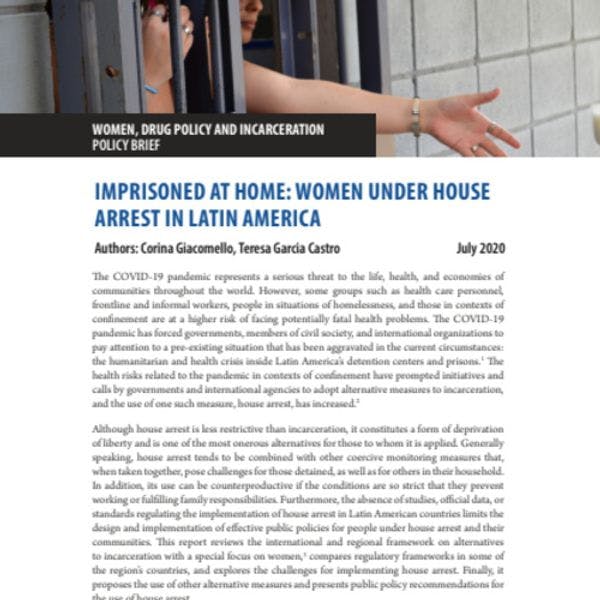L'emprisonnement chez soi : femmes placées en résidence surveillée en Amérique latine
Ce rapport souligne les opportunités et les dérives des mesures de résidence surveillée comme alternatives à l'emprisonnement. Pour en savoir plus, en anglais, veuillez lire les informations ci-dessous.
By CELS, Dejusticia, Equis: Justice for Women, the Institute for Judicial Investigations at the Autonomous University of Chiapas, IDPC, the Prison Ombudsman’s National Office in Argentina, Instituto Pro Bono & WOLA
COVID-19 has shed light on the need for governments across the Americas to take steps to address prison overcrowding, given the high risk of deadly outbreaks in places of detention where social distancing and other sanitary measures are difficult to achieve. In this context, some governments have promoted decarceration measures and alternatives to incarceration including house arrest—that is, court-ordered detention of a person in their place of residence—as a way to reduce overcrowding.
When implemented effectively, house arrest is meant to be a less restrictive form of confinement and to help those deprived of liberty reintegrate back into their communities and avoid landing back in prison. But as detailed in a new report, Imprisoned at Home: Women under House Arrest in Latin America, imposing strict house arrest without guaranteeing fundamental human rights, particularly for people in low-income situations, can make house arrest just as punitive as incarceration.
House arrest should not simply replace one form of incarceration for another. Governments across the Americas should guarantee that people subjected to this measure have their rights protected. If you’re placed under house arrest but aren’t given the option to remain employed or seek emergency medical help when you need it, those are unacceptable conditions. Authorities must ensure that those under house arrest receive the support they need to provide for their families and reintegrate into their communities.
The study focuses on the impact of house arrest on women across the Americas, given that, over the past two decades, the population of women deprived of liberty in this region has grown exponentially and the vast majority of these women come from situations of poverty and social exclusion, lending greater urgency to the need for alternatives to incarceration with a special focus on women. The report is the result of a collaboration between human rights and advocacy groups including the Center for Legal and Social Studies (Centro de Estudios Legales y Sociales, CELS), Dejusticia, Equis: Justice for Women, the Institute for Judicial Investigations at the Autonomous University of Chiapas (Instituto de Investigaciones Jurídicas de la Universidad Autónoma de Chiapas), the International Drug Policy Consortium (IDPC), the Prison Ombudsman’s National Office in Argentina, Instituto Pro Bono, and the Washington Office on Latin America (WOLA).
Testimony by women held under house arrest sheds light on how some of the challenges associated with home detention often remain hidden. When house arrest is implemented without accounting for an individual’s right to access education, work, healthcare, or food, it is worse than being in prison, some women said. Nora Laura Calandra, a formerly incarcerated woman from Argentina who now works as an advocate, described a case in which a woman who had gone into labor was told she couldn’t leave her house and go to the hospital without first receiving court authorization. Others noted that at least in prison, they were guaranteed something to eat.
If house arrest is implemented in overly harsh conditions, it’s counterproductive. For house arrest to be effective, it needs to be implemented in such a way that women can meet their basic needs, improve their living situation and resolve the underlying problems that led them to come into contact with the criminal justice system.
The report examines house arrest legislation in seven countries across the Americas—Argentina, Brazil, Colombia, the Dominican Republic, Ecuador, Mexico, and Peru—and includes case studies on the challenges for implementing house arrest effectively. Especially amid the COVID-19 pandemic, states are facing the critical task of reducing the population in prison—this will likely necessitate increasing the number of people under house arrest. But if authorities do not consider combining home detention with educational or job-training programs, evidence-based drug treatment programs, or other forms of community support, this severely limits the benefits of house arrest over incarceration, the report states.
More often than not, across the Americas house arrest is being used to harshly punish people when what’s needed are policies that actually protect the health and welfare of communities. Should COVID-19 make house arrest a more popular option as states look for ways to reduce prison overcrowding, it’s critical that authorities implement house arrest in a humane, rights-respecting way.
Téléchargements
Sujets
Régions
Profils associés
- Washington Office on Latin America (WOLA)
- International Drug Policy Consortium (IDPC)
- EQUIS Justicia para las Mujeres
- Dejusticia
- Corina Giacomello
- Centro de Estudios Legales y Sociales (CELS)
